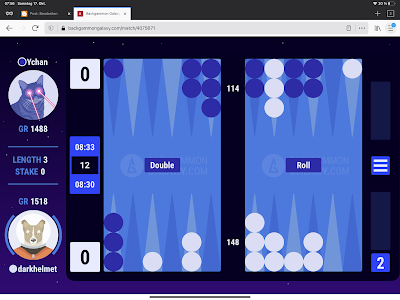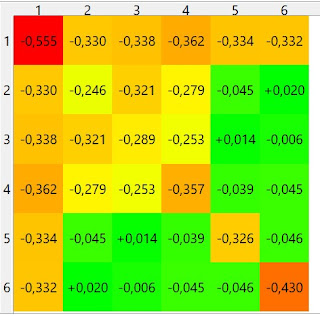Some time ago, in a social media service that doesn't exist anymore, I made a bold claim. I claimed that Backgammon is as complex as Chess and Go. People didn't agree, and without evidence I found it difficult to make my point.
Let me try this again, here in this blog :-). In Backgammon you come across several kinds of complexity, like making the right strategic decisions.
Making the right strategic decisions
Let's look at a few tricky positions in my recent (lost) match to 13 against Extreme Gammon Mobile (print and analysis by XG for the PC, Roller+) and see how tricky things can get in Backgammon.
Here I'm white and rolled 63. I have a couple of issues: there's the blot on 21 that I want to save before B hits it and occupies more slots in its home board. I've got no good home board whatsoever, and an awful stack on 6 that I need to shrink. So I thought it would be logical to play 21/15, 6/3, getting my blot in a safer place where XG can only hit it with a 3, and go for the 3 point with limited danger (only a 2 can hit me). Okay, in most cases it will hit me, but I hope to achieve one of my goals: save the blot or make an additional point.
I was wrong, but not by much (0.1 points of equity). The best play is more conservative: 21/15, 11/8. Probably my mistake was that if I get hit on the 3 point, both parts of my plan are moot - I have not made a point in my home board, and I have another blot left behind that it can attack.
Same game, one move later - XG rolled 63, hit my blot with 12/15, and moved 4/10. I rolled 41 and found myself in this tricky position:
Black has a lot of blots that I might want to hit. 20 with Bar/20*? Looks solid, lets me attack the blot on 15 in the next move, but weakens my blot on 3 even more (any 3, any 2 will hit it). Or hit on 10 with Bar/21, 11/10? I have nice builders on 11 and 10 then, my blot on 21 can hit its blots on 20 and 15. Or maybe I play conservative Bar/24, 7/3, have a 2-points board, save my blot on 3, and look which of its many blots I can hit on the next move?
I decided for Bar-20*, and yay! I was right. Actually my move and the conservative Bar /24, 7/3 get nearly the same score by XG, although they will lead to very different games. My other candidate move, Bar/21, 11/10 gets a beating by XG - it loses nearly 1/3 of the game (-0,29).
Calculating risks properly
A part of Backgammon where I really suck is calculating risks properly. Take a look at this position.
That's a fairly easy one, you would guess. And I still managed a major f..k up. My reasoning was: yes, this is my chance to fill my 1 spot, make a 5 board by playing 8/1, and all for the minimal risk that he might hit me on 8. XG tells me I lost half a point with this decision. The best move is the simple and conservative 13/8, 13/11. Why is my move so bad? You have to look at the dice distribution for black's next roll to understand:


The first image shows how the game will evolve after the best move. The second image shows my move. Two things can be seen: first: I underestimated that clearing the 13 point and keeping the 8 point is really important. All my followup moves are some 0.3 worse than necessary. And if it hits me with 11 (which it can also use to make the 21 point, I've moved my chances from 0.6 to -0.7. Keeping track of such "anti-jokers" is really important, because they can turn around the game in a single move.
That doubling cube
The doubling cube is a fiendish addition to Backgammon. I'm losing much more points by messing up my doubling than I do with poor moves. There's a couple of reasons: I forget to double because the action is so intense. I take where I should pass because I underestimated "anti jokers" like the one above. And I pass where I should take because I'm worn out and just want to stard a fresh game. Let's see a few examples.

For me, the situation was clear. There is a good chance that I can't enter my stone against XG's 4-point board. And if I do and hit at 23, I have this blot on 7, need to get 3 stones back. Pipcount is nearly equal. A clear "no double".
XG says I should double. I'm still confused why, when writing this. Probably I didn't consider that this is a match to 13, and in this position I'm trailing 4-10. If I double and can't enter, re-doubling is not as grave as normal because 4-14 is the same as 4-13. And as the AI believes I'm slightly leading, and have a few killer moves (2 + anything, 11), I should double.
Let's see another one:

Here I didn't double. I'm well ahead, but I'm scared of moves like 21 that would give XG two shots at my poor blot, while having a 5 point board. XG tells me the correct cube action actually is "double/pass".
It's roll distribution looks like this:

Yes, there are a number of really awful rolls for me. I didn't even think of the horrible 6-6 where I can't move at all, or 6-4, 4-4 where my blot not only stays in danger, but actually has to stay at its current spot, 4 and 6 points away from black stones, very likely to be hit. But most moves bring me to certain victory, and if your winning chances outrank your losing chances like that, you should double.
Stamina
Now this has nothing to do with the game itself, but I notice that in a match to 11 or 15 my performance degrades as we progress. In Backgammon, about half of the positions you get are totally straightforward. Some are immediately visible as tricky, and some look straightforward but you manage to not see an important move. And I, personally, manage to often miss important moves less later in the game.
Tactics - not so much
In my opinion, Backgammon delivers the same challenge concerning strategy, planning and mental stamina as Go and Chess do. But other than chess and go, Backgammon offers only very limited tactics. In Chess you need to play a number of likely move sequences in your mind to see how the game will evolve with this or that move. In Go, this is even more prominent, "reading" a position well is key to win local battles. In Backgammon, there's the dice, and calculating the outcome of the game with every single die combination is not something you can pull off. Really good players can detect critical "anti jokers", and the best bots look ahead 3 plys.
My conclusion
Backgammon is a much faster game than Go or Chess. Tournament chess and go matches use something like 3 minutes per move. Games typically last 6 hours. In Backammon, clocks are set to 2 minutes per match point. A tournament match to, say, 11 points then lasts for max 44 minutes. A single game lasts for something like 3 to 4 minutes. After all, the lengthy calculating of variations is not a part of backgamman, and this is the part of Chess and Go that eats most time.
And that's my conclusion: In terms of strategic complexity, Backgammon is a worthy peer to Chess and Go. But the combination calculations / tactics in those games are just not there in Backgammon...

























